

At Gatekeeper, we speak to a lot of prospective customers who come to market having known for a significant period of time that they need to improve their contract management disciplines.
In some cases, there might have been a specific trigger like a missed renewal or a new hire into the legal or compliance function, but in most instances it’s simply an increasing awareness over time that has reached a tipping point.
One of the reasons we’ve identified for this delay is a lack of a method for assessing the current level of performance in this area and the potential performance that could be reached.
Given that the difference between weak and strong performance in this area can be anywhere between 5% and 35% of overall contract spend, it’s something that should be prioritised much more highly.
And that’s before savings related to automation and improved risk-management are factored in.
So, how can you go about assessing your current capabilities?
Research and Business information firm, Gartner, have developed a model for just this purpose.
Their model has five maturity levels based on the increasing effectiveness or capability of an organisation's CLM processes.
The key principle is that there’s an inverse relationship between capability and risk, so the lower a business’s capability in this area, the higher the risk to which the business is exposed.
The model allows an organisation to determine where it sits on the capability continuum – its current maturity level – and provides a roadmap for improvement.
The five levels are as follows:
CLM Level 1: Ad Hoc
Some localised CLM processes are in place here and there, for purely local purposes. There is little to no formal or consistent documentation, the processes are applied to contracts only sporadically, and nobody is checking for compliance with the processes.
CLM Level 2: Basic
A few basic, organisation-wide CLM processes and standards exist, but are not mandated for use everywhere and are used only for contracts meeting certain standard criteria. Formal documentation exists for these contracts, but is not available everywhere. There is no policy regarding consistent CLM processes for all other contracts.
CLM Level 3: Structured
Mandatory organisation-wide processes and standards are applicable everywhere. Formal documentation is available everywhere. CLM processes and documents are specific to each unique contract type. Senior management is engaged and involved.
CLM Level 4: Integrated
CLM processes are fully integrated with other key business processes such as financial management and performance management. Certain end-user customers join with people from other business function to form part of buying and selling contract teams. Metrics are used to measure aspects of the CLM processes, and inform contract-related decisions.
CLM Level 5: Optimised
Across the organisation, performance metrics are used to assess the quality, efficiency, and effectiveness of CLM processes. A continuous improvement approach, and streamlining initiatives along with lessons learned and best-practices programs, are applied to the CLM processes.
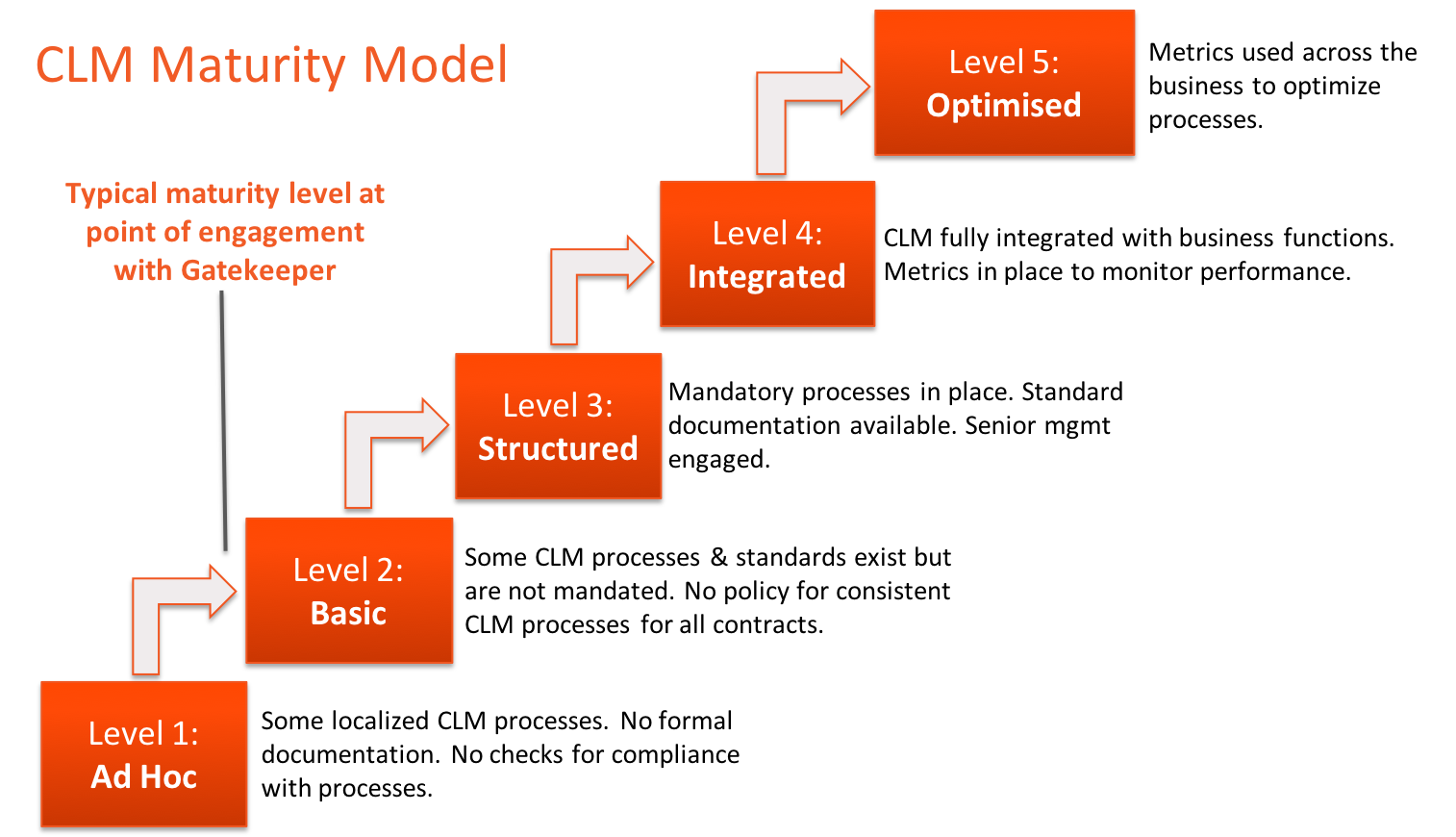
When you read through these five levels, you’ll likely be able to identify which one most closely resembles your business at the moment.
This will give you a good idea about what the steps are to take to reach higher levels of maturity and therefore to begin benefitting from lower costs, more efficiencies and lower business risk.
It’s also important to bear in mind that finding the right technology is only one part of improving maturity levels.
You need to coordinate your processes and people to embed CLM throughout your business. You can read about this in our related article – Two things you must do before selecting a Contract Management Solution.
The right technology will then facilitate the automation, the tracking and the measurement of your CLM processes.
There are a number of steps you can take to improve your contract management maturity levels – especially if your organisation is running at an ad-hoc or basic level.
While there is always room for improvement however mature your CLM capabilities are, businesses that fall within these two categories are most vulnerable to contract, supplier and regulatory risk.
Below, we take a look at some of the steps you should prioritise and how choosing the right contract management software can further support the alignment of people and processes throughout your organisation.
Businesses that take an ad-hoc or basic approach to contract management will be exposed to multiple risks as a result of poor contract visibility. When there is a lack of consistent and formal documentation, the following issues occur:
Formalising the way in which contracts and their metadata are captured and documented is the first critical step for businesses with low levels of maturity.
Without this step taking place, goal-setting becomes a wasted activity as required information may be missing, inaccurate or take too long to find.
Moving away from programmes such as Microsoft Excel that encourage disparate data and teams to adopt inconsistencies in the way they work should be the first consideration."
Instead, businesses should look to use contract repository software.
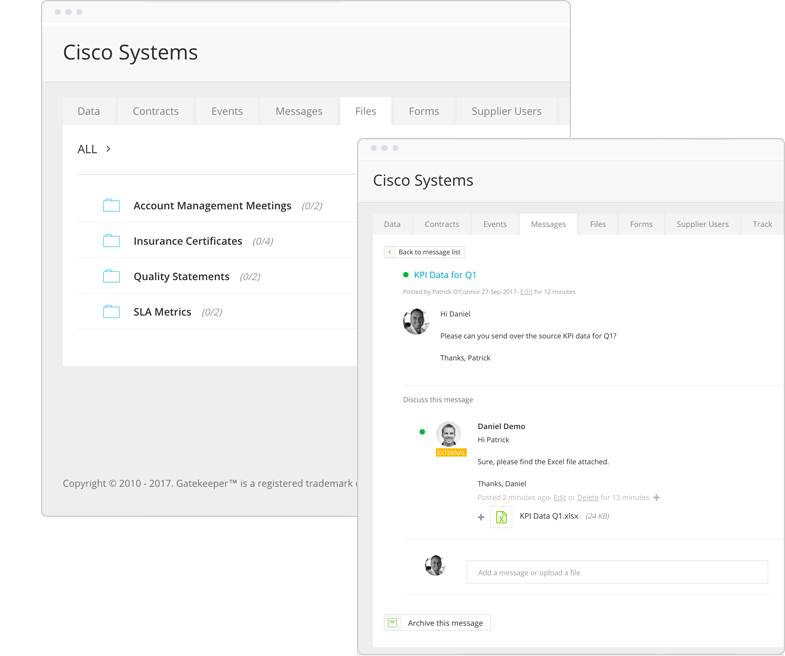
Centralise all contract information in Gatekeeper
By aligning people with this new technology, processes will naturally improve and be applied consistently across the organisation. By storing contracts and their metadata in a single and accessible location businesses can formalise documentation, have accuracy in the data they’re working with, improve overall visibility and set measurable goals.
The visibility created as a result of contract centralisation may uncover terms, obligations and requirements you were previously unaware of.
Obligations aren’t always static and can change as a business grows or suppliers alter their services, so it’s important to capture any contract amendments as and when they occur.
If amendments take place without organisation-wide knowledge, your business increases its contract risk and its likelihood to be non-compliant with updated contract obligations.
To get ahead of changing contract amendments, use a contract management solution that allows you to set role-based access permissions for approval control and tracking."
Not only will this allow you to assign ownership of contract amendments and approvals to team members who have seniority within the project but it will also create a fully visible and auditable trail of what changes were made and when – enhancing your visibility and understanding of contract obligations.
Understanding and complying with contract obligations not only ensures the smooth running of contracts but also embeds good relationships with your suppliers.
The stronger this relationship, the easier it is to work together towards the same goals including higher levels of compliance defined by local jurisdiction laws.
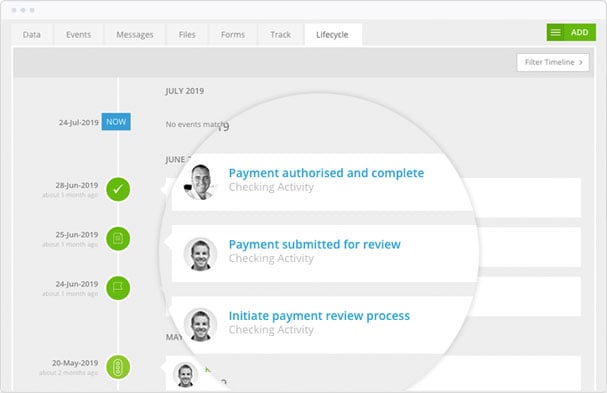 Track and record obligation fulfilment with audit trails
Track and record obligation fulfilment with audit trails
Failing to comply with contractual obligations can cause relationship damage with your suppliers, while failing to comply with regulations can cause financial and reputational damage.
Your approach to contract management needs to include contract risk monitoring and mitigation so you can reduce the opportunities for penalties and keep regulators happy.
Regulatory compliance will be based upon:
Third party suppliers will provide evidence, including certifications and reports, of their compliance efforts.
However, laws can be updated and certificates can expire so your business needs full visibility of documentation, compliance testing methods, reporting capabilities and a defined strategy in place to deal with instances of non-compliance.
Approaching monitoring and mitigation manually is inefficient and potentially allows instances of non-compliance to fall through the gaps, completely unnoticed."
Using contract management software helps your business to monitor and mitigate risk through:
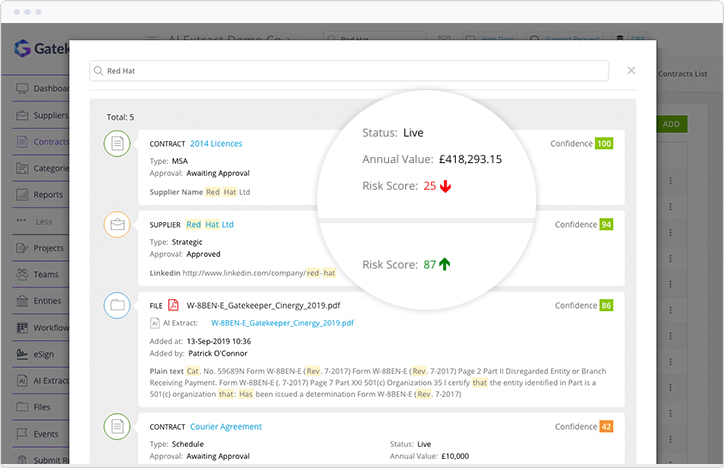
Your business is only ever as good as its suppliers and the service they offer. If they aren’t providing services on time, products are poor quality or they can’t deal efficiently with supply chain disruptions, your business will suffer the consequence.
Your operations could easily be disrupted, disputes can damage relationships and you won’t be realising the value from your contracts.
Early detection of poor supplier performance is paramount for keeping your operations running effectively."
With ad-hoc or basic levels of maturity, your organisation will have low levels of supplier visibility and time spent on admin workload will overtake time being spent on tracking, investigating and reviewing supplier performance.
Poor supplier performance can easily undermine your business without you even knowing the problems exist.
Implementing contract management software will unlock a new level of maturity that will help you to better manage supplier performance through:
Identifying potential supplier problems early on, being able to share relevant and accurate data with them and taking remedial action straight away can help you to ensure performance targets are met and contract value is realised.
![]() Monitor supplier performance with automated surveys
Monitor supplier performance with automated surveys
Having visibility of key dates helps to bring order and control to many areas of contract management. Key dates you should look to collate include when:
Having these dates centralised, fully visible and accessible to relevant members throughout the business can ensure that operations run without any interruption, cash continues to flow through the business, any issues are escalated and resolved, compliance is front of mind and all parties are collaborating effectively.
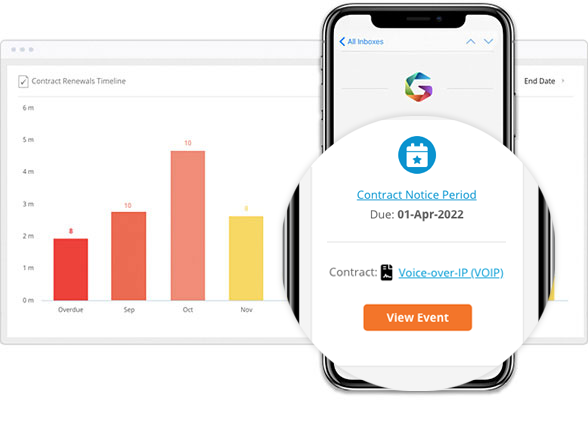 Stay ahead of key dates with automatic reminders
Stay ahead of key dates with automatic reminders
But there is also another key and critical date that your business should consider when it comes to managing contracts effectively: contract renewal dates.
Businesses often lose hundreds, if not thousands, of pounds to contracts that have auto-renewed without anyone knowing."
This can easily happen in businesses that take an ad-hoc or basic approach to management where dates aren’t extracted, known across the business and stored centrally.
Renewals are a critical date because they give you the opportunity to search the market for more cost-effective services if you act ahead of time. Carrying out a competitive review of the marketplace will allow you to see what else is out there and negotiate better terms.
With dedicated contract management software, you can receive notifications when a contract is coming up for renewal and take early action - saving you costs that may otherwise be hidden.
It’s important to assess your contract management capabilities to understand where there is hidden data, performance issues and risks of non-compliance throughout your business. We have created some free contract management resources to help you.
If your current approach is ad-hoc or basic, you can expect to uncover other issues too, such as operational inefficiencies and delinquent spend."
The results you glean from assessing your Contract Management capabilities may reveal that you need to put better processes in place, but your business isn't yet ready for a full CLM system. If this rings true, then take a look at simple CLM systems such as ContractNow that are designed to help you build a centralised, secure and searchable source of truth so you can take back control of your contracts.
If you would like more information on how to improve your CLM maturity levels and how to embed the right disciplines and technology in your business then contact us today for a free consultation.
If you would like more information on how to improve your maturity levels with CLM software and how to embed the right disciplines and technology in your business then contact us today for a free consultation.
Ready to improve your contract & vendor management?
.png)
.png)
.png)
-4.png)
Before Gatekeeper, our contracts
Anastasiia Sergeeva, Legal Operations Manager, BlaBlaCar
were everywhere and nowhere.
Gatekeeper is that friendly tap on the shoulder,
Donna Roccoforte, Paralegal, Hakkasan Group
to remind me what needs our attention.
Great System. Vetted over 25 other systems
Randall S. Wood, Associate Corporate Counsel, Cricut
and Gatekeeper rose to the top.
Thank you for requesting your demo.
Next Step - Book a Call
Please book a convenient time for a quick call to discuss your requirements.